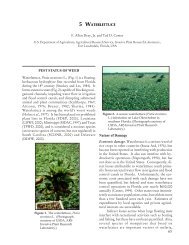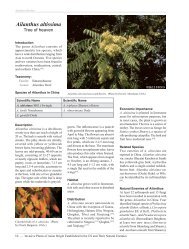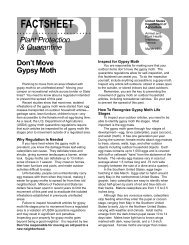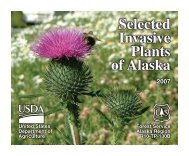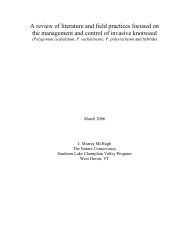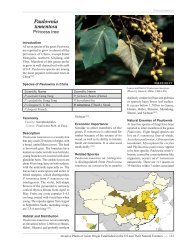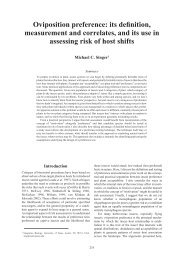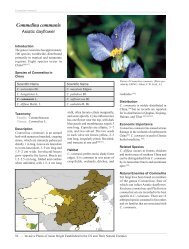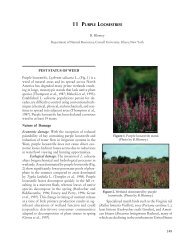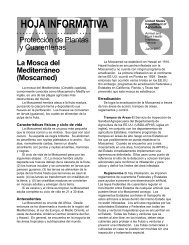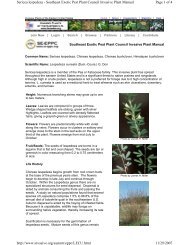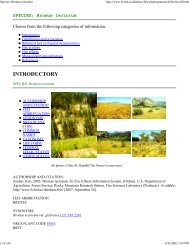A Guide to the Control and Management of Invasive Phragmites [PDF]
A Guide to the Control and Management of Invasive Phragmites [PDF]
A Guide to the Control and Management of Invasive Phragmites [PDF]
Create successful ePaper yourself
Turn your PDF publications into a flip-book with our unique Google optimized e-Paper software.
underst<strong>and</strong>ing phragmites<br />
control methods<br />
recommended management strategies<br />
fur<strong>the</strong>r information<br />
part 1<br />
part 2<br />
part 3<br />
part 4<br />
5<br />
Native<br />
<strong>Phragmites</strong><br />
typically has <strong>the</strong> following<br />
distinguishing traits:<br />
* Stems are reddish in <strong>the</strong> spring<br />
<strong>and</strong> summer <strong>and</strong> are smooth,<br />
shiny <strong>and</strong> flexible, while nonnative<br />
phragmites stems are tan <strong>and</strong><br />
rough, dull <strong>and</strong> rigid.<br />
* Leaves <strong>of</strong> native phragmites<br />
are lighter yellow-green,<br />
as opposed <strong>to</strong> dark blue-green.<br />
* Rhizomes rarely exceed<br />
15 millimeters in diameter<br />
<strong>and</strong> are yellow, as opposed <strong>to</strong><br />
white <strong>to</strong> light yellow.<br />
* Co-occurs with o<strong>the</strong>r plants,<br />
while nonnative phragmites<br />
typically grows as a monoculture.<br />
Plant Description<br />
<strong>Phragmites</strong> is a perennial, warm season grass that can grow in dense<br />
st<strong>and</strong>s <strong>and</strong> is long living.<br />
Plants can reach 15 feet in height, yet<br />
more than 80 percent <strong>of</strong> <strong>the</strong> yearly biomass<br />
is contained below ground in a<br />
dense mass <strong>of</strong> roots <strong>and</strong> rhizomes. Stalks<br />
support flat, stiff leaves that are 0.5–2.0<br />
inches wide near <strong>the</strong> base, tapering <strong>to</strong> a<br />
point at <strong>the</strong> end. <strong>Phragmites</strong> has graygreen<br />
foliage during <strong>the</strong> growing season,<br />
with distinctive purple-brown-silver seed<br />
head plumes appearing by late July.<br />
These plumes form at <strong>the</strong> end <strong>of</strong> stalks,<br />
are 6-20 inches long <strong>and</strong> up <strong>to</strong> 8 inches<br />
broad, <strong>and</strong> have many branches.<br />
<strong>Phragmites</strong> turns tan in <strong>the</strong> fall <strong>and</strong> most<br />
leaves drop <strong>of</strong>f, leaving only <strong>the</strong> stalk <strong>and</strong><br />
plume-<strong>to</strong>pped shoot throughout winter.<br />
Before attempting <strong>to</strong> control phragmites<br />
it is important <strong>to</strong> be able <strong>to</strong> identify <strong>the</strong><br />
native phragmites <strong>and</strong> o<strong>the</strong>r native plants<br />
that grow under similar conditions in<br />
Michigan’s coastal <strong>and</strong> interior wetl<strong>and</strong>s.<br />
Field guides <strong>and</strong> o<strong>the</strong>r resources can be<br />
used <strong>to</strong> identify o<strong>the</strong>r wetl<strong>and</strong> plants,<br />
<strong>and</strong> a website through Cornell University<br />
(http://www.invasiveplants.net/phragmites/<br />
phrag/morph.htm) can be used <strong>to</strong> identify<br />
native <strong>and</strong> nonnative phragmites.


![A Guide to the Control and Management of Invasive Phragmites [PDF]](https://img.yumpu.com/27321025/10/500x640/a-guide-to-the-control-and-management-of-invasive-phragmites-pdf.jpg)

